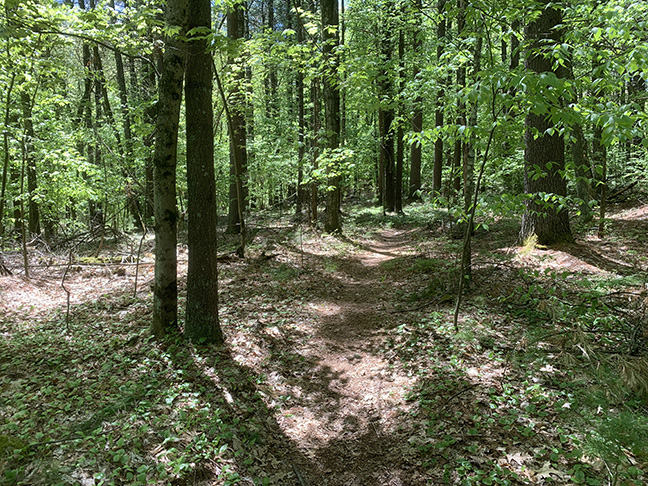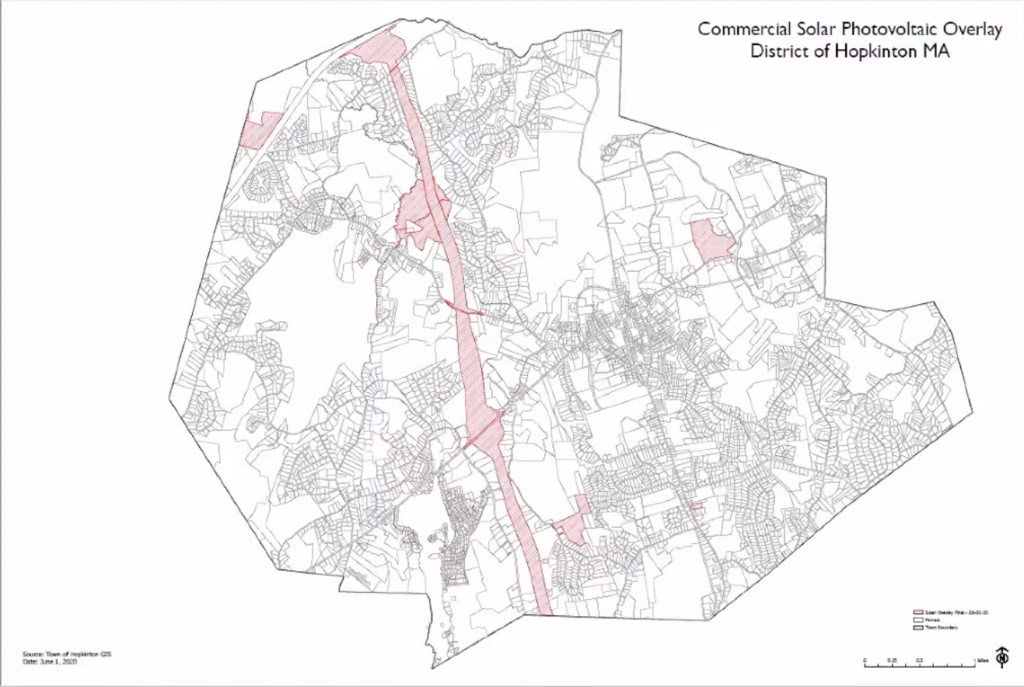During its meeting Monday night, the Planning Board voted to hold spots for two commercial zoning articles on the Town Meeting warrant, one dealing primarily with more aggressive screening rules and the other the previously submitted solar overlay district map.
The Zoning Advisory Committee last week had forwarded proposed bylaw changes that dealt primarily with the more strict screening rules, following advice from town counsel that the more restrictive options ZAC had discussed — including limiting commercial ground-mounted solar to industrial zones or on previously disturbed land — would be difficult to defend in court.
However, some Planning Board members — who acknowledged that they were not up to date on the ZAC discussions — said they were surprised that a new overlay district map wasn’t presented, and they pushed for the board to reconsider it.
After some discussion, the board voted unanimously to place the proposed bylaw update on the warrant, then voted 6-3 to hold another spot on the warrant for the proposed map, with the understanding that it could be pulled from the warrant following further discussion.
The board voted to submit six other articles, all of which are far less controversial items that the Planning Board had OK’d last year but were passed over during the abbreviated Town Meeting in an attempt to keep the meeting as brief as possible due to the pandemic.
All of the items still can be tweaked (with certain restrictions, according to principal planner John Gelcich), and a public hearing will be held to discuss them.
Planning Board member Mary Larson-Marlowe also serves as chair of the Zoning Advisory Committee, which was tasked with coming up with a new proposal to limit commercial solar.
“Unfortunately many of our ideas did get shot down by legal,” Larson-Marlowe said in her introduction of the proposed new bylaw to the Planning Board. “And the ultimate reason is that because of the way the state laws are written, we cannot treat solar development differently than other development. That means that we cannot even say, ‘Solar only in Industrial A and B [zones],’ for instance.”
She also noted that the proposed solar overlay district map — which is what the Planning Board had submitted to Town Meeting last year — similarly would be challenging to defend in court unless it included “a good 50 percent of the town in it or more,” per town counsel. The proposed map is far more restrictive than that.
“Ultimately what we could be allowed to do legally was simply increase the burden in terms of screening,” Larson-Marlowe said. “So, what we did is we beefed up screening both for noise, visual effect — that includes glare — and we put in some measurements that need to take place … about sight-line elevations.”
Added Larson-Marlowe: “It’s a lot of things to help the Planning Board assess whether or not the screening will be sufficient as proposed, as opposed to just seeing it on a two-dimensional plan — ‘Yeah, there’s trees there’ — but really not having any idea whether or not the elevation of the land makes the trees kind of irrelevant, that sort of thing. So, having these different types of measurements required to be given to the Planning Board in order to make the assessment is a big part of these changes as well.”
Board member Muriel Kramer questioned town counsel’s advice against limiting solar to certain zones.
“As far as limiting uses to zones, that’s what zoning does all the time,” she said. “So, that argument, on the surface, doesn’t sort of sway me. We all the time say that things can’t happen all over town but they can happen in certain zones. And this is a commercial use, and I think fundamentally that’s what we’ve heard from the public, is that they wanted to keep commercial uses like this from being planted in residential areas. So I’m a little confused about that assertion.”
Larson-Marlowe explained that, according to town counsel, solar has been given a “very special place in Massachusetts statute, and that is why it is not defensible — because it is allowed everywhere, all zoning districts, according to statute. And it cannot be treated differently than other developments.”
The board was complimentary of ZAC’s work in coming up with its plan.
“They came up with some really groundbreaking alternatives … that would give us substantial guidelines to make these solar arrays, wherever they might be, be amenable to the community,” said board member Jane Moran.
Whisper Way developer seeks bond reduction
In other Planning Board news, developer Chris Nation requested a reduction in the $112,000 performance guarantee estimate for Whisper Way (a development off Wood Street), saying some work already has been completed while questioning some of the planting requests, indicating he felt far fewer trees were needed. In some cases, he noted, there is no room for a tree because it’s either forested land or there is a barrier — such as a driveway or a fire hydrant.
“I can’t agree to something I can’t do,” Nation said.
BETA’s Phil Paradis indicated that the bylaw and the plan detail indicate trees should be planted every 40 feet, which is what he used as a guideline. Board chair Gary Trendel noted that the developer’s request was to have one tree approximately every 127 feet (11 trees over 1,400 feet).
Board member Dave Paul volunteered to do a site walk along with a landscape architect to get a better understanding of the situation.
“I find it hard to believe a brand new road can’t fit some trees on it,” Paul said. “Call me a skeptic.”
















0 Comments